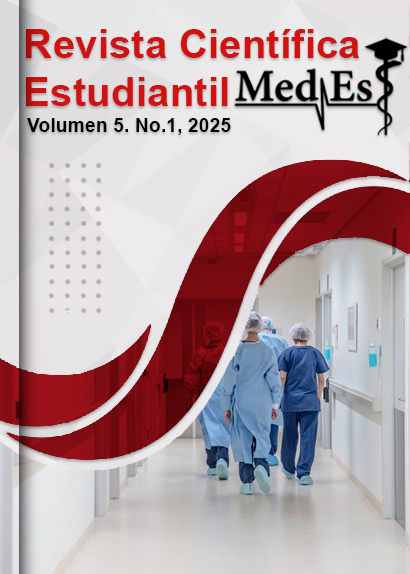Giant liver hemangioma. About a case
Keywords:
Abdominal pain, Hepatic hemangioma, Abdominal tumorAbstract
Introduction: Giant hepatic hemangiomas are usually less common than those measuring less than 5 cm. Giant hemangiomas can cause symptoms and present a higher risk of complications, such as traumatic rupture, so their management can be complex as there is currently no consensus on their treatment.
Objective: To describe the case of a patient with a giant hemangioma with a presentation of intense and disabling epigastric pain.
Case presentation: A 55-year-old female patient presented with epigastric pain associated with vomiting after eating, dark urine, and difficulty defecating. Imaging studies revealed a tumor in the left hepatic lobe consistent with a giant hemangioma, which displaced the head and body of the pancreas posteriorly.
Conclusions: Benign vascular liver tumors are mildly aggressive, very slow-growing, and mostly asymptomatic. However, giant and extremely giant hepatic hemangiomas can cause symptoms, ranging from diffuse, mild, and nonspecific pain to consumptive coagulopathy.
Downloads
References
1. González González AM, Palacios Morejón I, González Villalonga JA. Hemangiomas hepáticos: diagnóstico y manejo. Rev. Cub de Cirugía [Internet]. 2021 [citado 09/12/2024]; 59(1):56-62. Disponible en: http://scielo.sld.cu/scielo.php?script=sci_arttext&pid=S0034-74932021000100012
2. Barrera-Lozano L M, Ramírez JAR, Muñoz C L, Cerquera-Cajamarca S & Gutiérrez-Montoya JI. Manejo quirúrgico de hemangiomas hepáticos gigantes. Revista Colombiana de Cirugía. 2024 [citado 09/12/2024]; doi: https://doi.org/10.30944/issn.2011-7582
3. Gallardo Gómez F, Hernández Cruz RG, Miranda Araujo O, Rodríguez Bosch MR. Hemangioma hepático gigante en una mujer embarazada. Reporte de caso. Ginecol. obstet. Méx. [Internet]. 2021 [citado 09/12/2024]; 89(3): 262-266. Disponible en: http://www.scielo.org.mx/scielo.php?script=sci_arttext&pid=S0300-90412021000300010&lng=es
4. Ramos Batista A. Hemangioma Hepático Gigante. Presentación de un caso clínico. En Convención Científica HHA 2023. [Internet] 2023. [citado 09/12/2024]. Disponible en: https://convencionhha.sld.cu/index.php/convencionhha2023/2023/paper/view/945
5.Valdés Mas M, Ortiz Sánchez M L, Rodrigo Agudo J. L, Miras López M, Pons Miñano JA, Carballo Álvarez F. Hemangioma hepático gigante asociado a síndrome de Kasabach-Merrit. Rev. esp. enferm. dig. [Internet]. 2008 [citado 09/12/2024]; 100(8):511-513. Disponible en: http://scielo.isciii.es/scielo.php?script=sci_arttext&pid=S1130-01082008000800012&lng=es
6.Kacała A, Dorochowicz M, Matus I, Puła M, Korbecki A, Sobański M, et al.Hepatic Hemangioma: Review of Imaging and Therapeutic Strategies. Medicina (Kaunas). [Internet]. 2024 [citado 09/12/2024]; 8;60(3):449. Disponible en: https://pmc.ncbi.nlm.nih.gov/articles/PMC10972168/
7. Benavides C, García C, Rubilar P, Covacevich S, Perales C, Ricarte F, et al. Hemangiomas hepáticos. Rev Chil Cir [Internet]. 2006 [citado 09/12/2024]; 58(3):194-198. Disponible en: http://www.scielo.cl/scielo.php?script=sci_arttext&pid=S0718-40262006000300006&lng=es
Downloads
Published
How to Cite
Issue
Section
License
Copyright (c) 2025 Mercedes de la Caridad Rodríguez-Moreu , Frank Abel Chaviano-Alfonso , Sandra María Rodríguez-García , Yasmany Salazar-Rodríguez

This work is licensed under a Creative Commons Attribution-NonCommercial 4.0 International License.
Those authors who have publications with this journal accept the following terms: The authors will retain their copyright and guarantee the journal the right of first publication of their work, which will be simultaneously subject to the Recognition License. Creative Commons that allows third parties to share the work as long as its author and its first publication in this magazine are indicated. Authors may adopt other non-exclusive license agreements for the distribution of the published version of the work (e.g.: deposit it in an institutional telematic archive or publish it in a monographic volume) as long as the initial publication in this journal is indicated. Authors are allowed and recommended to disseminate their work through the Internet (e.g.: in institutional telematic archives or on your website) before and during the submission process, which can produce interesting exchanges and increase citations of the published work.





